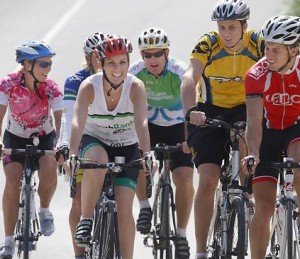How to ride with someone who is faster or slower
 It is very rare to find a group of recreational riders who ride at the same pace all the time. They’ll be riders who are having a good day, those who are having a bad day and just those (like me a lot of the time) who are just slower than many of their friends. For me, this is because many of them are men, and in general male riders are stronger than women.
It is very rare to find a group of recreational riders who ride at the same pace all the time. They’ll be riders who are having a good day, those who are having a bad day and just those (like me a lot of the time) who are just slower than many of their friends. For me, this is because many of them are men, and in general male riders are stronger than women.
But I don’t let that spoil my enjoyment of riding with friends and my pals are always very kind to me, and wait for me, and encourage me to improve. Likewise, I sometimes ride with others who are slower than me and I’m always kind and patient too.
I found this great article by Sarah Bonner published on the women’s cycling website Women’s Cycling and the editor Laurel-Lea kindly agreed for me to republish it here. Over to Sarah…..
Riding with a friend or a group with varying abilities can be frustrating. You might share a passion for cycling but your abilities might be mismatched. Whether you want to ride with a slower partner or join a faster group, here are some tips to get you on level ground.
- (Mis)match your rides: Aim to balance the speed of your rides. If you want to ride with a group or someone who is faster, ride with them on their slow day when you want to do a fast ride. Hopefully, since they have to ride slow and you are supposed to be riding faster, the speed of the ride will balance and satisfy both riders.
- Hill repeats: If you’re always waiting for someone at the top of a hill, stop waiting and start riding. Go back down the hill or just halfway and climb it again. You won’t be sitting around waiting, and the extra climbing will make you more tired, so you might not have to wait on the last few hills. If you’re the one being waited for, suggest this strategy to the faster rider.
- Slipstream: If you‘re the slower rider, take shorter turns (or no turns) on the front in the wind. If you’re the faster rider, let the slower rider sit in your slipstream for as long as they need to or for the whole ride. The energy savings for the slower rider in the slipstream, combined with the extra effort of the faster rider who is pulling on the front, should help even out the disparity between the cyclists. This strategy works in a group setting too. Just make sure everyone knows if you won’t be taking a turn at the front.
- Communication: The most important factor in cycling compatibility is communication. If riders know what to expect, they won’t be irritated when they are forced to wait or feel badly if they are holding up a group. Before your ride, talk about distance, speed, route, where you will congregate if you split up on a hill, and whether or not you feel strong enough to roll through the pace line or if you’ll be sitting in the line for the whole ride.
- Relax: Whether you are the faster or slower rider, remember that everyone had to start somewhere. Don’t stress about having to wait for someone or making someone wait. Every rider was a beginner and every rider, no matter how fast, has been dropped. Just relax and enjoy the ride!
Sarah Bonner has lived and cycled in Canada, Africa, and Europe. Currently, she splits her time between the Netherlands and South Africa where she trains and competes at an amateur level. With a Masters in English and a Diploma in Sports Management, Sarah combines her love of writing and passion cycling to share honest advice and inspiring stories. Follow her at sarahkimbonner.wordpress.com
